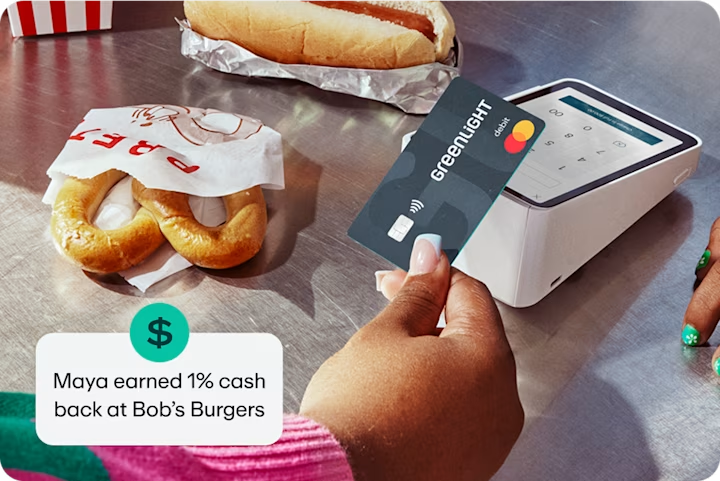
Can you build credit with a debit card?

Hey, $mart parents 💡
Bring money lessons home with Greenlight’s $mart Parent newsletter, a quick read with impactful tips — delivered free to your inbox weekly.
It’s a big moment when your kids or teens get their first debit card. They can use it to grab a snack, fill up their gas tank, check their balance in real-time, and start to see what it’s like to manage their own money. At some point, though, you might wonder: Are they building credit with a debit card?
Does using a debit card help build credit?
For most debit cards, the answer is no, you generally cannot build credit with debit cards.
Let’s see how building credit works, how teens can start to do it early, and why debit cards are still an excellent option for kids and teens.
How credit building works
Credit happens when you borrow money. Let’s say you open a credit account, like a credit card, a loan, or a line of credit. Every payment you make (or fail to make) is reported to the credit bureaus. Over time, that payment history, along with things like how much you owe and how long you’ve had accounts, becomes your credit history. That history shapes your credit score.
A debit card doesn’t go through this process. It’s connected to your checking account, so every purchase comes straight from the money you already have. No borrowing means you have nothing to repay. And without that, the credit bureaus have nothing to record.
If your kids or teens want to understand this better, walk them through the difference between debit and credit cards. Once they get that, you can look at strategies for credit building, like the ideas in our guide on how to build credit as a teen.
How teens can start building credit
When your teen has mastered managing their debit card, they can move on to building credit through a few relatively low-risk methods. Some common first steps include:
Become an authorized user on a parent's credit card. When you add your child as an authorized user on your credit card, their activity (and your payment history) is reported to credit bureaus, so they benefit from your positive payment habits and start building a credit history of their own
Use a secured credit card with a small deposit. This acts as collateral, and the card functions similarly to a regular credit card, with payments reported to credit bureaus.
Exploring a credit-builder loan. These loans are meant to help establish a payment history and build a score from scratch.
For a step-by-step approach, check out our guide on how to build credit without a credit card. And college-bound teens can also learn more with our tips on how to build credit as a college student.
Why debit cards are still valuable for kids and teens
While debit cards don’t directly build credit, they’re still one of the best first steps when you want to teach your kids and teens how to manage their money.
With a debit card, kids and teens learn how to:
Notice spending habits. Looking back at their transactions can be eye-opening! Maybe half their money was spent on coffee runs, or that streaming service they stopped watching is still charging them every month.
Stay on a budget. Because the balance changes immediately after each purchase, teens can see the effect in real-time. It’s an instant feedback loop that helps them slow down spending before the account runs dry.
Avoid debt. Since they can only use the money already in the account, they’re more likely to get used to living within their means without interest charges or unexpected bills.
These valuable debit card lessons make the move to credit much smoother. Kids and teens who’ve practiced with a debit card already know how to pace their spending and keep an eye on their balance.
How Greenlight helps kids and teens get ready for credit
Greenlight’s debit card isn’t designed to build credit; it’s designed to foster the healthy money management habits and financial confidence teens need before taking on borrowing.
With Greenlight, kids and teens can:
Set and track savings goals
Learn budgeting skills with real-time spending insights
Earn up to 6% on savings* (depending on your plan)
Use in-app educational tools to understand credit before they ever apply for it
Parents get tools, too. You can review transactions, set spending limits, and approve or decline purchases in real time. It’s a balance between giving kids and teens freedom and maintaining a safety net.
When the time comes for your teen to apply for a credit card or loan, they’ll already know how to manage money and avoid overspending. That kind of early experience is hard to beat.
Want credit-savvy kids? Help teens learn about credit responsibly with Greenlight, the award-winning educational money app. Try Greenlight one month, risk-free.†
*Greenlight Core families can earn 2% per annum, Greenlight Max families can earn 3% per annum, Greenlight Infinity families can earn 5% per annum, and Greenlight Family Shield families can earn 6% per annum on an average daily savings balance of up to $5,000 per family. To qualify, the Primary Account must be in Good Standing and have a verified ACH funding account. See Greenlight Terms of Service for details. Subject to change at any time.
†Valid for new customers only. Subject to identity verification and minimum load requirements. Your first monthly fee will be billed to your parent wallet seven days after successful registration. To receive a refund of your first monthly fee, you must request to close your account on or before the day immediately preceding your first Monthly Billing Date. See the ‘Account’ tab of Settings by tapping the gear icon on the Greenlight app home page to confirm when your risk-free trial ends. See Terms for details.
Share via
